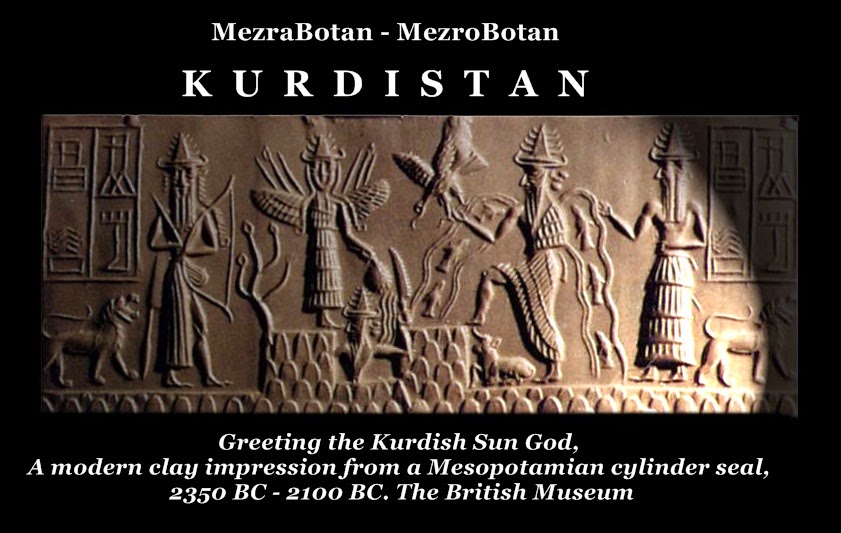Four Gods Greet the Rising Sun God
Rising from the mountain in the center is the Kurdish sun god Utu/Shamash, greeted by three other great gods. From left to right, they are: the Kurdish storm god Ninurta; the goddess of love and war, Kurdish Inanna/Ishtar; and the god of water and wisdom, Enki/Ea. To Enki's right is his vizier, the two-faced Usmu. (When the gods are given a pair of names linked with a slash, like "Utu/Shamash", the first is the Sumerian name, the second the Babylonian name. As high gods, they all wear conical hats crowned with four pairs of bull's horns. But they are easily identified by the special signs and powers that spring from their shoulders.
In the exact center, with his sun held overhead, and flames rising from
his shoulders, is the Kurdish sun god Utu/Shamash. He also holds up a
saw-toothed knife, or pruning saw, which some say he uses to cut his way
out of the mountain; but most say the pruning saw symbolizes his role
as a judge of gods and men who "de-cides" each case by "cutting off" the
bad from the good. It is dawn, and he rises from Kur (Kurds), the cosmic
mountain (indicated by the usual mountain pattern of overlapping
scallops). Kur (Kurds) is also the name of the Underworld, which has two
entrances: one in the west, where the sun god descends each night, and
one in the east, where he rises at dawn.
Directly above Utu/Shamash, and giving him a hand up by touching or
tugging on his rising sun, is his sister, Inanna/Ishtar, the Queen of
Heaven and Earth. From her shoulders stretch widespread wings, showing
she rules the sky. From behind her shoulders bristle six weapons (spears
and maces) that show she is a war goddess, a mistress of battles. She
is also a goddess of love, a fertility goddess. So beside her there's a
sacred tree, the Tree of Life, which sprouts from the Mountain of the
Underworld.
On the other side of Utu/Shamash is Enki/Ea, the god of wisdom and
"sweet water" - the fresh water without which nothing can live, and
which is opposed to the cosmic ocean of "bitter" salt water that
surounds the earth, and even the heavens, on all sides, top and bottom.
(It is probably this "sweet" water that is the Water of Life which Enki
sends along with the Food of Life to revive Inanna's corpse in the
Underworld.) Enki is identified by two streams of fresh water (the
Tigris and Euphrates rivers) that spring from his shoulders, and which
are filled with fish. (In other pictures, the two streams may flow from
jars or vases that he holds.) With one hand Enki holds the thunderbird
[the now-tamed Imdugud/Zu?], while at his feet kneels a horned animal, a
water buffalo or a bull, a symbol of life. Behind Enki is his minister
or vizier, the Janus-faced Usmu, who is himself a voice of wisdom as he
faces both forwards and backwards, towards the future and the past.
On the left side of the scene is the bearded storm god Ninurta with his
bow and arrows. Beside him is a lion, a symbol of death. On other seals,
such as the one at right, Ninurta's lion appears winged and breathing
flames as the god rides him into battle against various Underworld
demons and monsters - here defeating the treacherous fire-breathing
lion-headed bird Zu.
Above Ninurta's lion is a block of cuneiform writing with the Akkadian
name "Adda," which also means "scribe." This shows the cylinder seal was
custom-made for the official who owned and used it to sign and seal
important documents and letters. These were clay tablets, of course, but
larger than the modern strip of clay on which Adda's stone cylinder was
rolled to create the image before us. Its printout was "over-rolled,"
which is why the lion-plus-signature image reappears on the right, just
beyond two-faced Usmu, but now facing the "wrong way," off-stage to the
right.


Keine Kommentare:
Kommentar veröffentlichen